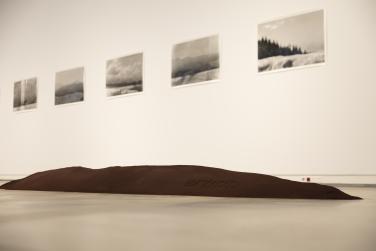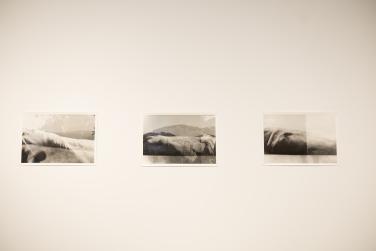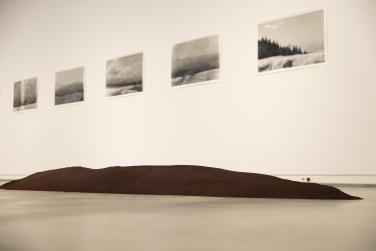Gâv
Author: Kimia Kamvari
Year: 2018-2024
Material: Analogue printing on baryta paper
Dimensions: variable
Gala
Author: Kimia Kamvari
Year: 2024
Material: Galalita
Dimensions: 35 x 4 x 2 cm
Capital
Author: Kimia Kamvari
Year: 2018-2024
Material: Analogue printing on baryta paper
Dimensions: variable
Cows calmly graze on an open land, open air, some standing still, others lying on the grass, sunbathing, ruminating and shaping the land. This image could belong to any land and any time, maybe a déjà vu of an ancestral dream. What is a cow’s view? In Behi euskaldun baten memoriak, a novel by Bernando Atxaga, this stillness and this profound time is described through a cow’s point of view.
I read somewhere that the origin of the word Geo or Gaia is the word Gâv (گاو), which means “cow” in Persian. When I went deeper into the topic, I found myths and stories that relate or somehow liken the cattle to the earth. Gaia, the wide-bosomed god that arose after Chaos, is the ancestral mother in Greek mythology and the personification of the earth. The word is the poetic form of Gê or Gâ meaning “earth” and “land”. The opening of the 12th century Persian poem, The Conference of the Birds, illustrates a scene of the world’s creation: After nailing the mountains to the earth, [The Creator] washes the earth from the sea / the earth stands straight on the back of the cow, the cow on the back of a fish and the fish in the air. This image is derived from an ancient Persian belief, the legend of Gâv-Zamin (Cow-Earth), in which the world is depicted identically: the earth balanced on a cow’s back, which stands atop a fish suspended in the air.
I took these photographs years ago, in my first years of living in the Basque Country. I was trying to capture the animal body as a layer against the mountainous horizon, and to blur the cow’s back with the mountain hillside. When I first received the offer to take part in this exhibition, during various conversations with the curator, these photos came into play and I started to work with a couple of film rolls that accidentally were double exposed and damaged with light intrusions. At that time, I was also thinking about ending breastfeeding, so milk as a matter became very present in my thoughts. The decision to cut off the flow of milk drew my thoughts straight to the relation between nurture and care on the one hand, and violence on the other. Thinking of this bodily flow drew me to think of another body's fluid: blood.
While I was shaping the idea, the assault on Gaza began and a week after, the Iranian filmmaker Dariush Mehrjui and his wife were assassinated by knife in their home in Karaj. This killing echoed the chain murders of the '90s, in which Iranian dissident intellectuals were targeted both in Iran and abroad. Therefore, for this exhibition, my work, my voice and myself are unified in response to these acts of killing.
Gâv (The Cow, 1969), directed by Darioush Mehrjui, titles an expressive film of the history of Iranian cinema. It depicts the strong relationship between a middle aged peasant and his cow, which is his only valuable property. After the mysterious death of the pregnant cow in the barn, the villager gradually goes insane and believes he is the cow to the extent that he begins to embody the cow.
In Zoroastrian cosmogony, the creation of the primordial bovine Gav-aevo-data (the uniquely created ox) goes very parallel to the primordial human being Gayo-mart (the uniquely created man). The primordial ox is an hermaphrodite having both milk and semen and a progenitor of all beneficiary animal life. It is described as bright white like the moon, dwelling on one bank of the river Veh, while the mythical first human lived on the opposite bank. The film flows like the river, or perhaps it crosses it, unifying human and animal beings in the same stream.
We can find several cases in which the act of killing a cow opens doors to other scenarios. In Zoroastrianism, the death of the primordial bovine repopulates the world with animal life, grains and medicinal plants. Islam and Judaism share the same narrative of the sacrifice of the Red Heifer. In the second chapter of the Quran titled Al-Baqarah (The Cow), it is said that when a murder happens and the murderer is unknown, an organ of the sacrificed cow should be placed upon the corpse, so the dead will revive to reveal its murderer before dying again. In the Torah, The Red Heifer should be sacrificed, burned to ashes and brought to a priest in order to purify the body of the murderer or the body of anyone who has been in contact with the corpse. In both cases, the sacrifice of a cow operates as a ritual that purifies the toxicity that remains in the killer's body and cleanses the spiritual pollution that pervades their mind.
In other religions such an act of killing would be sacrilege, tantamount to homicide, if not a greater sin. In Dharmic religions, for instance, killing a cow is a taboo associated with violence against all other species and the protection of cows is a symbol of animal rights and non-violence towards all forms of life.
A friend of mine once visited a small slaughterhouse in Oñati and described the operation to me in vivid detail. Apparently it is a very fast process, not just from start to finish, but from cow to cow. First, the cows are pushed to move forward. As they advance, barriers are fixed behind them to prevent them from retreating. If they resist, they are subjected to electric shocks. As soon as the first in the queue makes it into the cramped cage at the end, it's stunned with a captive bolt and immediately after, a lateral wall of the cage opens and it's laid down on its back. Another person continues the job, tying one leg to a lift and cutting its throat with a large knife. While the animal is exsanguinating, he turns to the previous cow in the queue and cuts off its horns as it hangs. Another stunned animal enters. They enter one after another, with the burly worker in between juggling three cows at a time. The work was tough, my friend emphasized, and is not paid as it should.
Some reports on slaughterhouses in the US talk about underaged and undocumented immigrants working in very harsh conditions. There are statistics on the high risk of repetitive physical harm, like amputations and finger loss, strain injuries and workers are instructed to wear ear protectors to prevent their hearing from constant screams of animals being killed. Probably the worst thing, worse than the physical danger, is the emotional toll. A system that lets you kill but prevents you from taking care.
The division of things prevents us from understanding larger realities behind. Once humans settled down and agriculture and pastoralism led to abundant food supplies, population increased and specialisation and division of labour led to the formation of complex societies. The most complex of all, capitalism, lives on the exploitation of the workers, whose unpaid labour is the ultimate source of surplus value. Dead labour feeding on the living, as Marx would say. The term capital is borrowed from Latin capitālis (of the head of cattle), derived from caput (capitĭa), in turn from the Proto-Indo-European root kaput- (head). Just as Marx reminded us, eight heads entered the cave of Cacus, facing backwards, pulled by the tail. Far from the image of the rowers of Oteiza, where the rowers advance backwards, looking at the past or at what exists, there is no advance when what they claim to give us is something that was stolen from us before.
Astigarreta 2024
(Kimia Kamvari)



